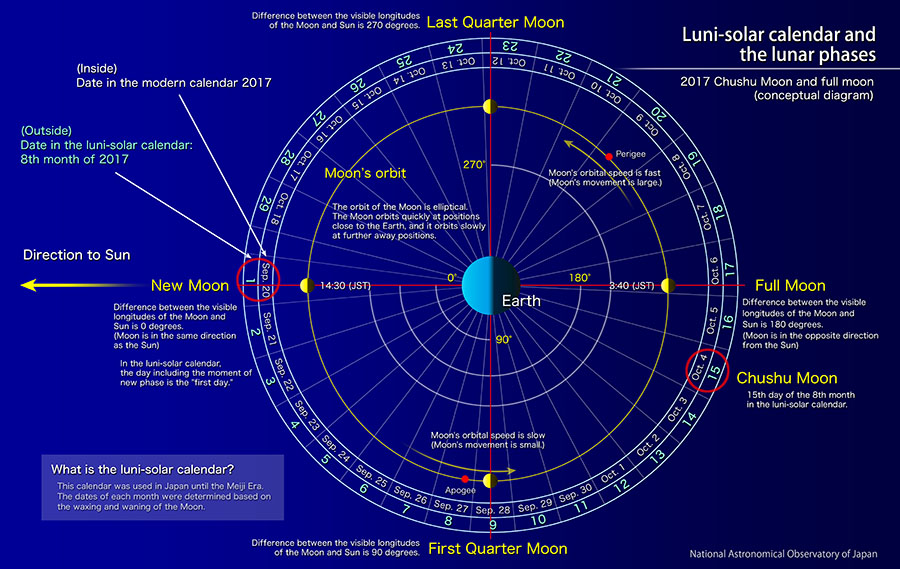The Chushu Moon (October, 2017)

The Chushu Moon is Not Always a Full Moon
This year’s Chushu Moon is on October 4.
In the “luni-solar calendar (Note 1),” the moon on the evening of the 15th day of the 8th month (Note 2) is called the “Chushu Moon.” In Japan, it is also referred to as the “Imo-meigetsu” in connection with agricultural events. In Japan, people used to serve taros from ancient times on Imo-meigetsu. The tradition of viewing the Chushu Moon is said to have been transmitted from China during the Heian Era. In addition, the 13th night of the 9th month in the luni-solar calendar is known as “the 13th Evening.” In Japan, it is traditional to also conduct moon viewing on that evening. The 13th Evening Moon is also called “the Latter Moon,” “the Mame-meigetsu,” or the “Kuri-meigetsu.” This year the 13th Evening falls on November 1.
More than a few people think, “We can see a beautiful moon during the Chushu Moon; and the Chushu Moon is the full moon.” But, October 4 is the Chushu Moon this year and October 6 is the full moon. So, the dates of the full moon and the Chushu Moon are two days apart. In fact, the date of the full moon and the Chushu Moon are often different.
How does this happen? In the luni-solar calendar, the "first day" is the day including the moment when the Moon passes new phase. The Chushu Moon indicates the Moon on the 15th day of the 8th month in the luni-solar calendar. As shown in the figure above, September 20, which includes the moment when the Moon passes new phase, is the first day of the 8th month in the luni-solar calendar. Also, October 4 is the 15th day of the 8th month in the luni-solar calendar.
On the other hand, the full moon is defined astronomically by the positions of the Sun, the Earth, and the Moon. The full moon refers to the Moon when the Moon and the Sun are in opposite directions as seen from the Earth (the Moon is exposed to sunlight directly from the front so that seen from the Earth, the Moon looks round.) As shown in the figure above, we will have the moment of full moon at 3:40 on October 6.
While the Moon orbits around the Earth, it repeats waxing and waning with a period of about 29.5 days. However, the Moon does not always become full phase in 14.75 days, which is half of this orbital period. This is because the Moon’s orbit is not a perfect circle, instead it has a squished oval shape. The orbital speed is fast when the Moon is close to the Earth, and on the other hand, the orbital speed is slow when the Moon is far from the Earth. Therefore, the number of days it takes from the new moon until the full moon varies greatly from 13.9 days to 15.6 days. This time, it took about 15.5 days from the new moon to the full moon.
From these reasons, the dates of the Chushu Moon and full moon can be different. However, the Moon is very bright on several days before and after the full moon. It might be impressing. This year, we can enjoy a beautiful Chushu Moon that is just as good as a full moon.
(Note 1) This calendar was used in Japan until the Meiji Era. The days of each month were determined based on the waxing and waning of the Moon. Back
(Note 2) Although it is called the 8th month, this year there was a leap-month between the 5th and 6th months, so that this is actually the 9th month of 2017. Back